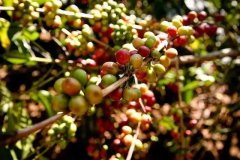Coffee roasting degree coffee roaster coffee beans death wish coffee
The term "fine coffee" was first put forward by Ms. Knudsen of the United States in Coffee and Tea magazine. At that time, Ms. Knudsen, as a coffee buyer of B.C. Ireland in San Francisco, was very dissatisfied with the neglect of the quality of raw coffee in the industry, and even some big roasters mixed a large amount of Robesda beans in the comprehensive beans, so she put forward the concept of fine coffee to advocate the improvement of the quality of the industry. This term is used to describe coffee beans with distinctive flavor characteristics that grow in a special environment. Its use in international coffee conferences makes it spread rapidly.

The baking degree determines the trend of taste spectrum.
A. "shallow baking": from the middle of the explosion to the end of the explosion, Agtron#75-#66.
Most of the aromatic compounds formed by "shallow baking" are low molecular weight compounds, and the aroma and taste are easy to identify, including sour aroma, herbs, cinnamon, nutmeg, shell, nuts and toast, with the lightest weight and the highest volatility. The flowers of coffee
The sour aroma is the product of "enzyme action", while the smell of shell and bread is the smell in the early stage of Mena reaction in the baking process. The two construct the main taste spectrum of shallow baking.
B. "medium roasting" means Agtron#65-#55 from the end of the first explosion to before the second explosion.
The aromatics of "medium baking" are mainly medium molecular weight compounds with slightly higher mass and moderate volatility, mainly furan compounds (Furan) and pyrazine compounds (Pyrazine), and also have the characteristics of rising into the nasal cavity, which is the mid-term product of caramelization and Mena reaction in the baking process. The aroma is dominated by caramel, cream sugar and chocolate. Although medium baking still has sour flavor, nutty and toast flavor, it is obviously weaker than "light baking".
C. "medium-deep roasting" refers to the violent explosion from the first to the middle of the second explosion, Agtron#54-#40.
D. "Deep roasting" means two exploding tails, Agtron#40-#30.
The aromatics of "medium and deep baking" and "deep baking" are high molecular weight compounds with higher mass than the former two, with low volatility and almost no sour fragrance. They are the products of dry distillation at the end of baking, mainly mercaptan, resin, tar and phenolic compounds, and can be summarized as turpentine, alcohol, tar, choking incense, and the sweet and bitter taste of caramel and caramel.
Three sources, nine charm
After baking, raw beans produce many odors that promote and suppress each other, including fruit, caramel, cream, resin, wine, rice and wheat, stew, pepper, pizza and spice. It is difficult to find a main flavor for coffee
Therefore, the sources of coffee aroma can be divided into three categories: "enzyme action", "sugar browning reaction" and "dry distillation".
a. Shallow baking highlights the "enzyme effect":
1. "Hua Yun", 2. "Fruit Rhyme", 3. "Herbal Rhyme".
b. Medium baking highlights the "sugar browning reaction":
1. "Nut rhyme", 2. "caramel rhyme", 3. "Chocolate rhyme".
C deep baking highlights "dry distillation":
1. "resin rhyme", 2. "Xin Xiang Yun", 3. "charcoal burning rhyme".
Important Notice :
前街咖啡 FrontStreet Coffee has moved to new addredd:
FrontStreet Coffee Address: 315,Donghua East Road,GuangZhou
Tel:020 38364473
- Prev

Characteristics of boutique coffee beans join machine boutique coffee shop coffee
Characteristics of boutique coffee beans 1. Boutique coffee beans must be high-quality beans with flawless beans. It should have an outstanding flavor, not without a bad taste, but with a particularly good taste. two。 Boutique coffee beans must be excellent varieties, such as the original bourbon species, mocha species and Tippica species. The coffee beans produced by these trees have a unique aroma and flavor, far beyond the ability of other tree species.
- Next

What do you think of the new coffee flavor wheel death wish Coffee
The purpose of "Coffee Flavor Wheel" is to establish the same term of coffee taste spectrum, to assist cup testers or professionals to further understand the connotation of coffee aroma and taste, and to describe the sensory understanding of coffee in the future, so as to have a common language. In order to facilitate the analysis, the Coffee Flavor Wheel is disassembled into two fan-shaped diagrams. This issue will first introduce the "odor spectrum". Coffee taste spectrum consists of "odor spectrum" and "nourishment".
Related
- Beginners will see the "Coffee pull flower" guide!
- What is the difference between ice blog purified milk and ordinary milk coffee?
- Why is the Philippines the largest producer of crops in Liberia?
- For coffee extraction, should the fine powder be retained?
- How does extracted espresso fill pressed powder? How much strength does it take to press the powder?
- How to make jasmine cold extract coffee? Is the jasmine + latte good?
- Will this little toy really make the coffee taste better? How does Lily Drip affect coffee extraction?
- Will the action of slapping the filter cup also affect coffee extraction?
- What's the difference between powder-to-water ratio and powder-to-liquid ratio?
- What is the Ethiopian local species? What does it have to do with Heirloom native species?

